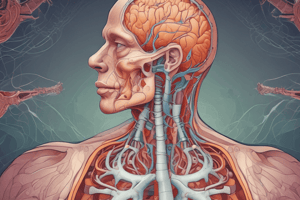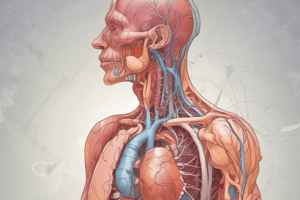Podcast
Questions and Answers
What structures make up the respiratory zone where gas exchange occurs?
What structures make up the respiratory zone where gas exchange occurs?
- Nasal cavity and larynx
- Bronchi and trachea
- Pharynx and nasal sinuses
- Respiratory bronchioles and alveoli (correct)
Which of the following statements correctly describes the primary function of the upper respiratory tract?
Which of the following statements correctly describes the primary function of the upper respiratory tract?
- It is responsible for voice production.
- It houses the alveolar sacs for gas exchange.
- It filters, warms, and moistens air before reaching the lungs. (correct)
- It facilitates the exchange of oxygen and carbon dioxide.
Which part of the respiratory system is known to contain sinuses?
Which part of the respiratory system is known to contain sinuses?
- Alveoli
- Lungs
- Upper respiratory tract (correct)
- Lower respiratory tract
What is the function of the septum in the nasal cavity?
What is the function of the septum in the nasal cavity?
Which of the following accurately describes the role of the epiglottis during swallowing?
Which of the following accurately describes the role of the epiglottis during swallowing?
Which component of the respiratory system is primarily responsible for voice production?
Which component of the respiratory system is primarily responsible for voice production?
Which of the following correctly identifies the anatomical feature responsible for the larger size of the Adam's apple in males?
Which of the following correctly identifies the anatomical feature responsible for the larger size of the Adam's apple in males?
What condition results from the improper formation of the palatine bone?
What condition results from the improper formation of the palatine bone?
The process of pulmonary ventilation can be described as:
The process of pulmonary ventilation can be described as:
Which structure is found at the base of the skull and has three divisions?
Which structure is found at the base of the skull and has three divisions?
Which of the following structures is directly involved in gas exchange between the air and the blood?
Which of the following structures is directly involved in gas exchange between the air and the blood?
Where is the bronchial tree located in the respiratory system?
Where is the bronchial tree located in the respiratory system?
Why does air flow into the lungs during inspiration?
Why does air flow into the lungs during inspiration?
Which of the following accurately describes the arrangement of cartilage within the trachea?
Which of the following accurately describes the arrangement of cartilage within the trachea?
Which of the following accurately describes the function of the cilia lining the respiratory tract?
Which of the following accurately describes the function of the cilia lining the respiratory tract?
Which of the following is NOT a characteristic of the bronchi?
Which of the following is NOT a characteristic of the bronchi?
What is the primary function of the respiratory system in relation to homeostasis?
What is the primary function of the respiratory system in relation to homeostasis?
Which of the following structures is NOT part of the conducting zone of the respiratory system?
Which of the following structures is NOT part of the conducting zone of the respiratory system?
What role does the respiratory system play in adjusting the pH of body fluids?
What role does the respiratory system play in adjusting the pH of body fluids?
Which of the following best describes the purpose of the conducting zone?
Which of the following best describes the purpose of the conducting zone?
Which of the following statements about respiration is false?
Which of the following statements about respiration is false?
What is the main function of the alveoli within the respiratory system?
What is the main function of the alveoli within the respiratory system?
Which characteristic distinguishes the respiratory zone from the conducting zone?
Which characteristic distinguishes the respiratory zone from the conducting zone?
Which of the following is NOT a goal of respiration?
Which of the following is NOT a goal of respiration?
Flashcards are hidden until you start studying
Study Notes
Physiology Overview
- Physiology studies body functions and how various body parts operate.
- It examines mechanisms in living systems, focusing on organisms, organs, and cells.
- As a subdiscipline of biology, it helps understand chemical and physical functions.
Respiratory System
- Essential for maintaining homeostasis through gas exchange of oxygen and carbon dioxide.
- Assists in pH regulation of body fluids.
Definitions of Respiration
- Oxygen intake and carbon dioxide expulsion by the lungs.
- Gas exchange between external atmosphere and body cells.
- Transport of oxygen from air to tissues and carbon dioxide from tissues to air.
Goals of Respiration
- Deliver oxygen to tissues.
- Remove carbon dioxide from tissues.
- Air conditioning: warms, cools, moistens, and cleans incoming air.
Functional Division of the Respiratory System
- Conducting Zone: Series of cavities and tubes facilitating air conduction.
- Respiratory Zone: Areas within the lungs where gas exchange occurs.
Conducting Zone
- Comprises the nose, nasal cavity, pharynx, larynx, trachea, bronchi, bronchioles, and terminal bronchioles.
- Functions to filter, warm, and moisten air.
Respiratory Zone
- Includes respiratory bronchioles, alveolar ducts, alveolar sacs, and alveoli.
- Main sites for gas exchange between air and blood.
Structural Divisions of the Respiratory System
- Upper Respiratory System: Nose, nasal cavity, pharynx, and related structures.
- Lower Respiratory System: Larynx, trachea, bronchi, and lungs.
Structures of the Upper Respiratory Tract
- Nose: Warms and moistens air; contains rich blood supply.
- Palatine Bone: Separates nasal cavity from mouth; cleft palate can lead to swallowing/speaking difficulties.
- Septum: Divides nostrils; prone to nosebleeds.
- Sinuses: Four air-filled spaces that lower skull weight.
Pharynx
- Extends from the base of the skull to the esophagus; consists of:
- Nasopharynx: Behind nose, can be blocked by enlarged adenoids.
- Oropharynx: Behind mouth, includes tonsils.
- Laryngopharynx: From hyoid bone to esophagus.
Structures of the Lower Respiratory Tract
- Larynx (Voice Box): Connects throat to trachea; composed of cartilage with vocal cords.
- Thyroid Cartilage: Adam's apple, larger in males due to testosterone.
- Epiglottis: Flap that closes off trachea during swallowing.
Trachea and Bronchi
- Trachea: Windpipe leading from larynx to bronchi, comprised of C-shaped cartilage rings.
- Bronchi: Branch from trachea into lungs, ciliated with primary, secondary, and tertiary branches.
Bronchioles and Alveoli
- Bronchioles branch into microscopic ducts that lead to alveolar sacs.
- Alveoli are the sites of gas exchange with blood.
Lungs
- Extend from diaphragm to clavicles; divided into lobes by fissures.
- Visceral pleura adheres to lung surfaces.
Respiratory Physiology
- Pulmonary Ventilation: The act of breathing.
- Air movement occurs due to pressure gradients; air flows from areas of high to low pressure.
- Inspiration occurs when lung pressure is less than atmospheric pressure, while expiration occurs when lung pressure exceeds atmospheric pressure.
- Thoracic cavity size changes lead to pressure differentials: increased thorax size lowers pressure, drawing air in, whereas decreased size raises pressure, expelling air.
Studying That Suits You
Use AI to generate personalized quizzes and flashcards to suit your learning preferences.



